Nonstationary Streamflow Variability and Climate Drivers in the Amur and Yangtze River Basins: A Comparative Perspective Under Climate Change
Abstract
1. Introduction
2. Materials and Methods
2.1. Study Area
2.2. Data Sources
- Discharge Data
- Hydrometeorological Data
2.3. Methods
- Nonstationary Analysis of Streamflow Time Series
- Definition and Characterization of Extreme Events
- Attribution of Climatic Drivers Using Lagged Random Forests
- Slope-based Attribution Method:
3. Results
3.1. Streamflow Nonstationarity Characteristics
3.1.1. Interannual Trends and Abrupt Changes
3.1.2. Periodicity and Long-Term Oscillations
3.1.3. Seasonal Patterns of High and Low Discharges
3.2. Characteristics of Extreme Streamflow Events
3.2.1. Intra-Annual Distributions of Extremes
3.2.2. Interannual Variability and Changing Intensity
3.3. Attribution Analysis: Climate and Regulation Drivers
3.3.1. Climatic Controls on Streamflow Variability
3.3.2. Engineering Impacts and Slope-Based Attribution
4. Discussion and Conclusions
Author Contributions
Funding
Data Availability Statement
Conflicts of Interest
Appendix A
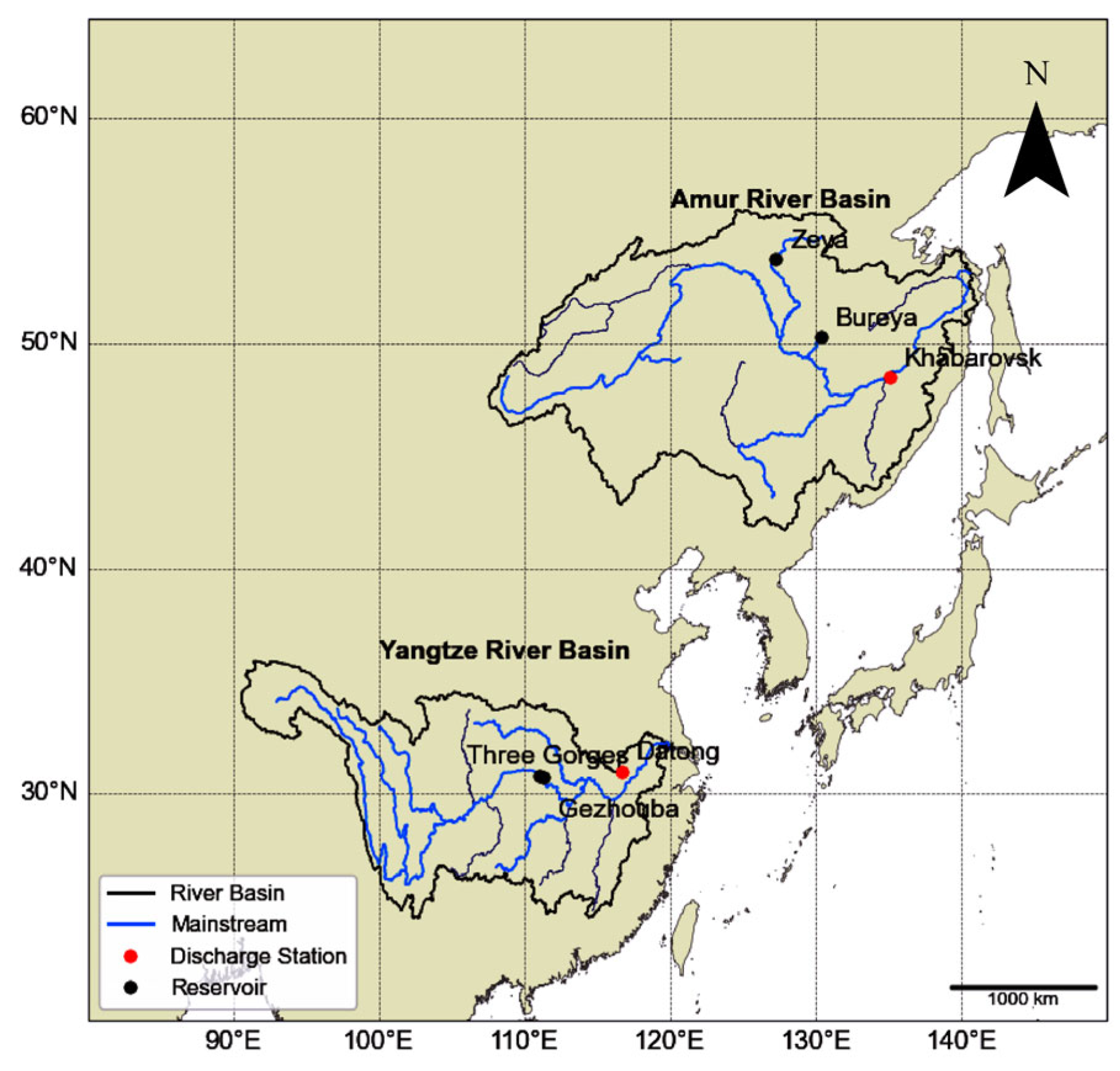


References
- Zhou, Z.Z.; Ren, J.; He, X.G.; Liu, S.G. A comparative study of extensive machine learning models for predicting long-term monthly rainfall with an ensemble of climatic and meteorological predictors. Hydrol. Process. 2021, 35, e14424. [Google Scholar] [CrossRef]
- IPCC. Climate Change 2021: The Physical Science Basis. Contribution of Working Group I to the Sixth Assessment Report of the Intergovernmental Panel on Climate Change; Cambridge University Press: Cambridge, UK, 2021. [Google Scholar] [CrossRef]
- Zhou, Z.Z.; Smith, J.A.; Baeck, M.L.; Wright, D.B.; Smith, B.K.; Liu, S.G. The impact of the spatiotemporal structure of rainfall on flood frequency over a small urban watershed: An approach coupling stochastic storm transposition and hydrologic modeling. Hydrol. Earth Syst. Sci. 2021, 25, 4701–4717. [Google Scholar] [CrossRef]
- Lei, N.; Gao, L.S.; Liu, S.G.; Zhou, Z.Z. The Spatiotemporal Clustering of Short-Duration Rainstorms in Shanghai City Using a Sub-Hourly Gauge Network. Earth Space Sci. 2024, 11, e2023EA003442. [Google Scholar] [CrossRef]
- Gnann, S.J.; Howden, N.J.K.; Woods, R.A. Hydrological signatures describing the translation of climate seasonality into streamflow seasonality. Hydrol. Earth Syst. Sci. 2020, 24, 561–580. [Google Scholar] [CrossRef]
- Johnson, Z.F.; Stuivenvolt-Allen, J.; Mahan, H.; Meyer, J.D.D.; Miksch, M. Upper Colorado River Streamflow Dependencies on Summertime Synoptic Circulations and Hydroclimate Variability. J. Hydrometeorol. 2024, 25, 277–291. [Google Scholar] [CrossRef]
- Aryal, A.; Shrestha, M.; Aryal, S.; Upadhyay, S.; Maharjan, M. Spatio-temporal variability of streamflow in major and medium rivers of Nepal. J. Hydrol. Reg. Stud. 2023, 50, 101590. [Google Scholar] [CrossRef]
- Zhang, K.W.; Ma, K.; Leng, J.W.; He, D.M. Alteration in Hydrologic Regimes and Dominant Influencing Factors in the Upper Heilong-Amur River Basin across Three Decades. Sustainability 2023, 15, 10391. [Google Scholar] [CrossRef]
- Tang, R.; Dai, Z.; Mei, X.; Lou, Y. Joint impacts of dams and floodplain on the rainfall-induced extreme flood in the Changjiang (Yangtze) River. J. Hydrol. 2023, 627, 130428. [Google Scholar] [CrossRef]
- Shakarami, L.; Ashofteh, P.-S.; Singh, V.P. Disaggregating the effects of climatic variability and dam construction on river flow regime. Water Resour. Manag. 2022, 36, 3813–3838. [Google Scholar] [CrossRef]
- Cui, T.; Tian, F.; Yang, T.; Wen, J.; Khan, M.Y.A. Development of a comprehensive framework for assessing the impacts of climate change and dam construction on flow regimes. J. Hydrol. 2020, 590, 125358. [Google Scholar] [CrossRef]
- Liu, Y.M.; Duffy, K.; Dy, J.G.; Ganguly, A.R. Explainable deep learning for insights in El Nino and river flows. Nat. Commun. 2023, 14, 339. [Google Scholar] [CrossRef] [PubMed]
- Yun, X.; Tang, Q.; Li, J.; Lu, H.; Zhang, L.; Chen, D. Can reservoir regulation mitigate future climate change induced hydrological extremes in the Lancang-Mekong River Basin? Sci. Total Environ. 2021, 785, 147322. [Google Scholar] [CrossRef]
- Ashraf, M.S.; Ahmad, I.; Khan, N.M.; Zhang, F.; Bilal, A.; Guo, J. Streamflow variations in monthly, seasonal, annual and extreme values using Mann-Kendall, Spearmen’s Rho and innovative trend analysis. Water Resour. Manag. 2021, 35, 243–261. [Google Scholar] [CrossRef]
- Garba, H.; Udokpoh, U.U. Analysis of trend in meteorological and hydrological time-series using Mann-Kendall and Sen’s slope estimator statistical test in Akwa Ibom state, Nigeria. Int. J. Environ. Clim. Change 2023, 13, 1017–1035. [Google Scholar] [CrossRef]
- Das, S.; Banerjee, S. Investigation of changes in seasonal streamflow and sediment load in the Subarnarekha-Burhabalang basins using Mann-Kendall and Pettitt tests. Arab. J. Geosci. 2021, 14, 946. [Google Scholar] [CrossRef]
- Yin, L.; Wang, L.; Keim, B.D.; Konsoer, K.; Zheng, W. Wavelet analysis of dam injection and discharge in three gorges dam and reservoir with precipitation and river discharge. Water 2022, 14, 567. [Google Scholar] [CrossRef]
- Liu, X.; Zhang, X.; Kong, X.; Shen, Y.-J. Random forest model has the potential for runoff simulation and attribution. Water 2022, 14, 2053. [Google Scholar] [CrossRef]
- Wang, X.W.; Zhu, Y.; Chen, Y.N.; Zheng, H.L.; Liu, H.N.; Huang, H.B.; Liu, K.; Liu, L. Influences of forest on MODIS snow cover mapping and snow variations in the Amur River basin in Northeast Asia during 2000–2014. Hydrol. Process. 2017, 31, 3225–3241. [Google Scholar] [CrossRef]
- Nikitina, O.I.; Dubinina, V.G.; Bolgov, M.V.; Parilov, M.P.; Parilova, T.A. Environmental Flow Releases for Wetland Biodiversity Conservation in the Amur River Basin. Water 2020, 12, 2812. [Google Scholar] [CrossRef]
- Yu, M.; Li, Q.; Lu, G.; Cai, T.; Xie, W.; Bai, X. Investigation into the Impacts of the Gezhouba and the Three Gorges Reservoirs on the Flow Regime of the Yangtze River. J. Hydrol. Eng. 2013, 18, 1098–1106. [Google Scholar] [CrossRef]
- Li, Y.; Yan, D.H.; Peng, H.; Xiao, S.B. Evaluation of precipitation in CMIP6 over the Yangtze River Basin. Atmos. Res. 2021, 253, 105406. [Google Scholar] [CrossRef]
- Yang, L.; Zhao, G.J.; Tian, P.; Mu, X.M.; Tian, X.J.; Feng, J.H.; Bai, Y.P. Runoff changes in the major river basins of China and their responses to potential driving forces. J. Hydrol. 2022, 607, 127536. [Google Scholar] [CrossRef]
- Kiem, A.S.; Franks, S.W. On the identification of ENSO-induced rainfall and runoff variability: A comparison of methods and indices. Hydrol. Sci. J. 2001, 46, 715–727. [Google Scholar] [CrossRef]
- Nummelin, A.; Ilicak, M.; Li, C.; Smedsrud, L.H. Consequences of future increased Arctic runoff on Arctic Ocean stratification, circulation, and sea ice cover. J. Geophys. Res. Ocean. 2016, 121, 617–637. [Google Scholar] [CrossRef]
- Wang, Y.; Ye, A.; Zhang, Y.; Yang, F. The quantitative attribution of climate change to runoff increase over the Qinghai-Tibetan Plateau. Sci. Total Environ. 2023, 897, 165326. [Google Scholar] [CrossRef]
- Kendall, M.G. Further Contributions to the Theory of Paired Comparisons. Biometrics 1955, 11, 43–62. [Google Scholar] [CrossRef]
- Sen, P.K. Estimates of the regression coefficient based on Kendall’s tau. J. Am. Stat. Assoc. 1968, 63, 1379–1389. [Google Scholar] [CrossRef]
- Pettitt, A.N. A Non-Parametric Approach to the Change-Point Problem. J. R. Stat. Soc. Ser. C (Appl. Stat.) 1979, 28, 126–135. [Google Scholar] [CrossRef]
- Goupillaud, P.; Grossmann, A.; Morlet, J. Cycle-octave and related transforms in seismic signal analysis. Geoexploration 1984, 23, 85–102. [Google Scholar] [CrossRef]
- Zhang, X.; Yang, F. RClimDex (1.0) user manual. Clim. Res. Branch Environ. Can. 2004, 22, 13–14. [Google Scholar]
- Breiman, L. Random forests. Mach. Learn. 2001, 45, 5–32. [Google Scholar] [CrossRef]
- Chen, H.; Chen, L.H. Response of runoff variation to the changing environments of karst regions in southwest China. Hydrol. Sci. J. 2022, 67, 2344–2357. [Google Scholar] [CrossRef]
- Baklanov, P.; Voronov, B. Threats and Risks to Sustainable Development in the Amur River Basin. Rep. Amur-Okhotsk 2010, 6, 315–325. [Google Scholar]
- Evgrashin, V. Construction of the Zeya hydro development. Hydrotech. Constr. 1973, 7, 1121–1125. [Google Scholar] [CrossRef]
- Guan, Y.H.; Zheng, F.L.; Zhang, X.C.; Wang, B. Trends and variability of daily precipitation and extremes during 1960-2012 in the Yangtze River Basin, China. Int. J. Climatol. 2017, 37, 1282–1298. [Google Scholar] [CrossRef]
- Wang, Y.; Rhoads, B.L.; Wang, D. Assessment of the flow regime alterations in the middle reach of the Yangtze River associated with dam construction: Potential ecological implications. Hydrol. Process. 2016, 30, 3949–3966. [Google Scholar] [CrossRef]
- Makhinov, A.; Makhinova, A. Assessment of the Impact of Climate Change on the Hydrological Regime of the Amur River in the Lower Reaches. Geogr. Nat. Resour. 2022, 43, S68–S73. [Google Scholar] [CrossRef]
- Yang, P.; Zhang, S.; Xia, J.; Zhan, C.; Cai, W.; Wang, W.; Luo, X.; Chen, N.; Li, J. Analysis of drought and flood alternation and its driving factors in the Yangtze River Basin under climate change. Atmos. Res. 2022, 270, 106087. [Google Scholar] [CrossRef]
- Wei, W.; Chang, Y.; Dai, Z. Streamflow changes of the Changjiang (Yangtze) River in the recent 60 years: Impacts of the East Asian summer monsoon, ENSO, and human activities. Quat. Int. 2014, 336, 98–107. [Google Scholar] [CrossRef]
- Jia, S.Z.; Yang, Y.P. Spatiotemporal Characteristics and Driving Factors of Land-Cover Change in the Heilongjiang (Amur) River Basin. Remote Sens. 2023, 15, 3730. [Google Scholar] [CrossRef]
- Chalise, D.R.; Sankarasubramanian, A.; Ruhi, A. Dams and Climate Interact to Alter River Flow Regimes Across the United States. Earths Future 2021, 9, e2020EF001816. [Google Scholar] [CrossRef]
- Nalley, D.; Adamowski, J.; Biswas, A.; Gharabaghi, B.; Hu, W. A multiscale and multivariate analysis of precipitation and streamflow variability in relation to ENSO, NAO and PDO. J. Hydrol. 2019, 574, 288–307. [Google Scholar] [CrossRef]
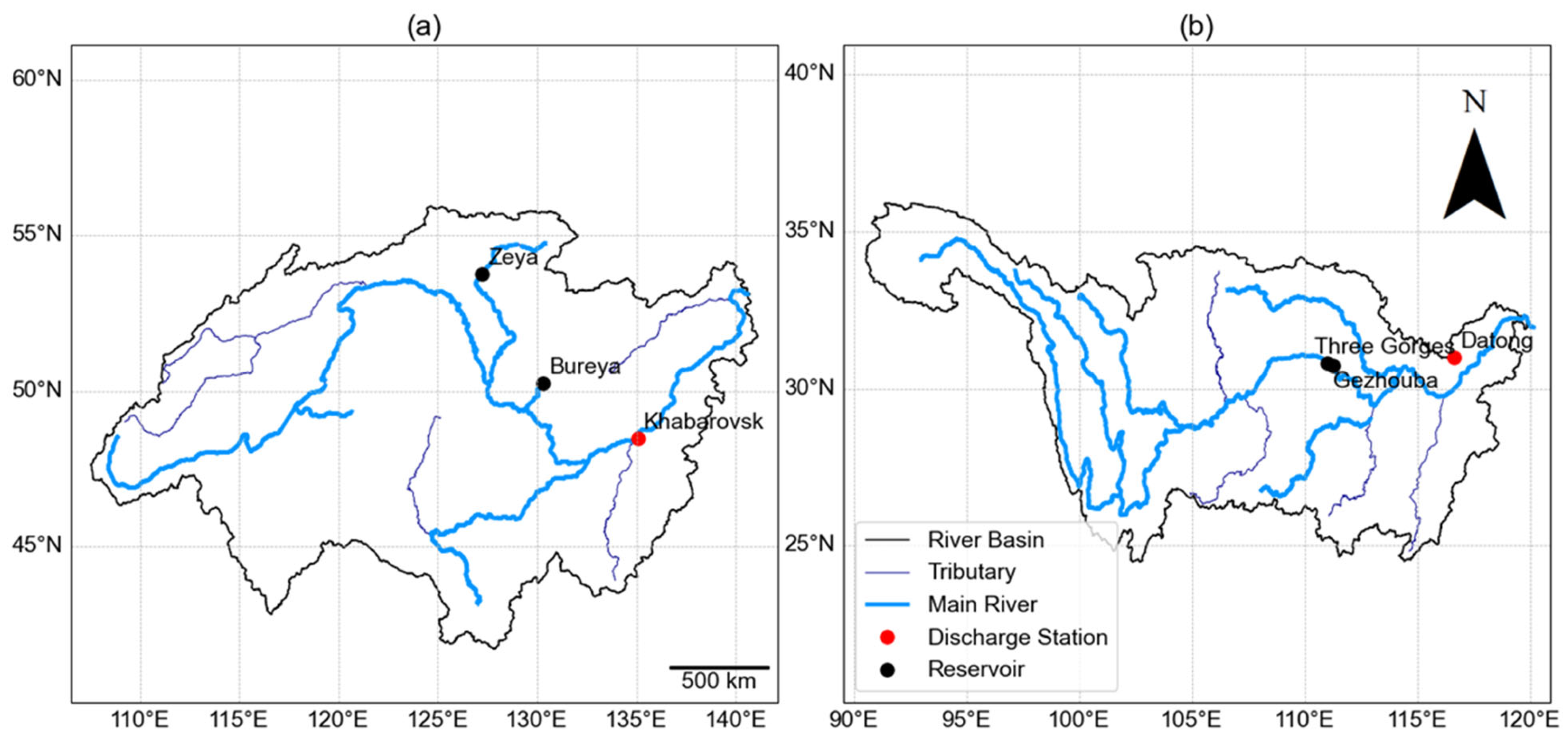
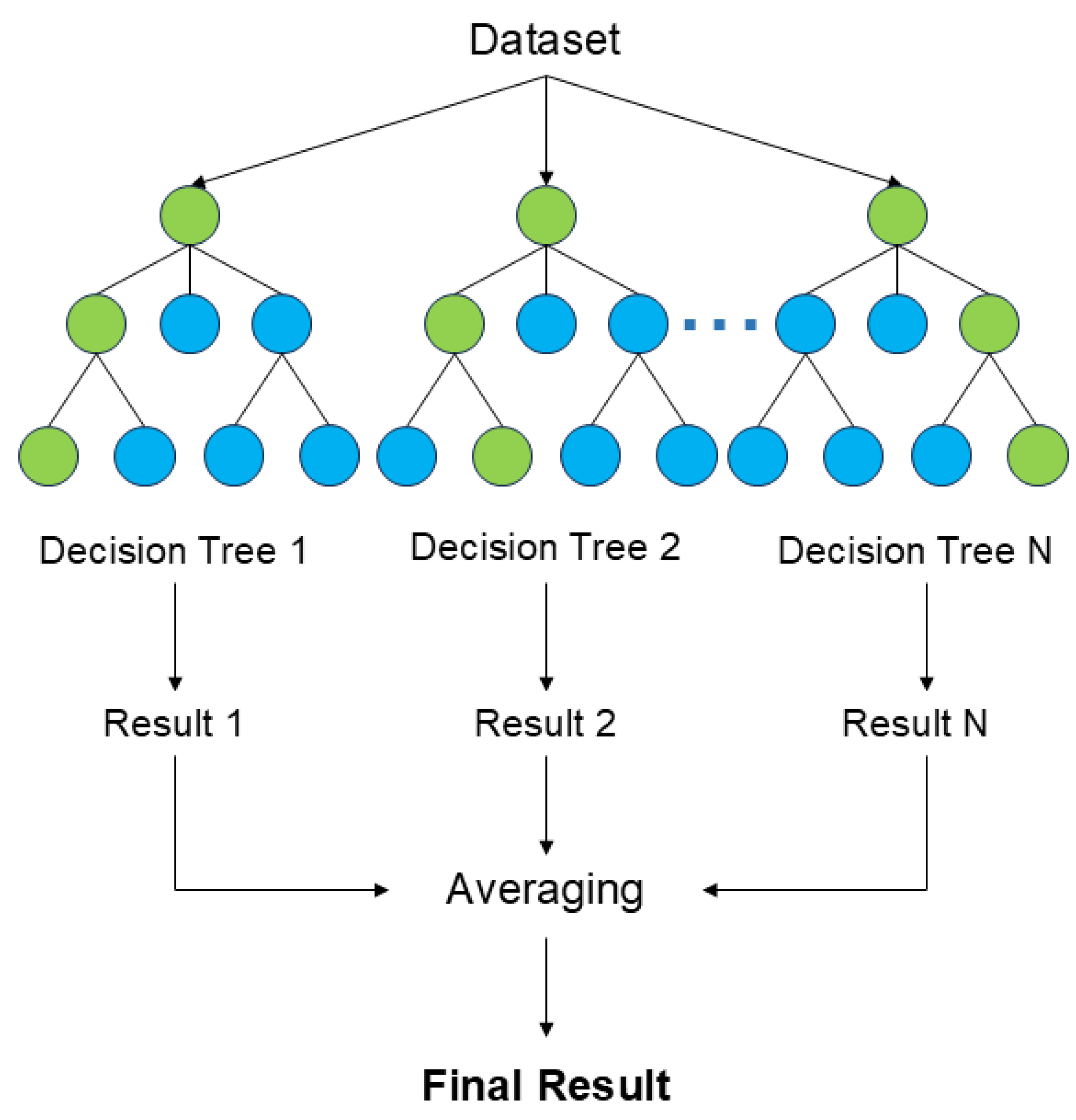
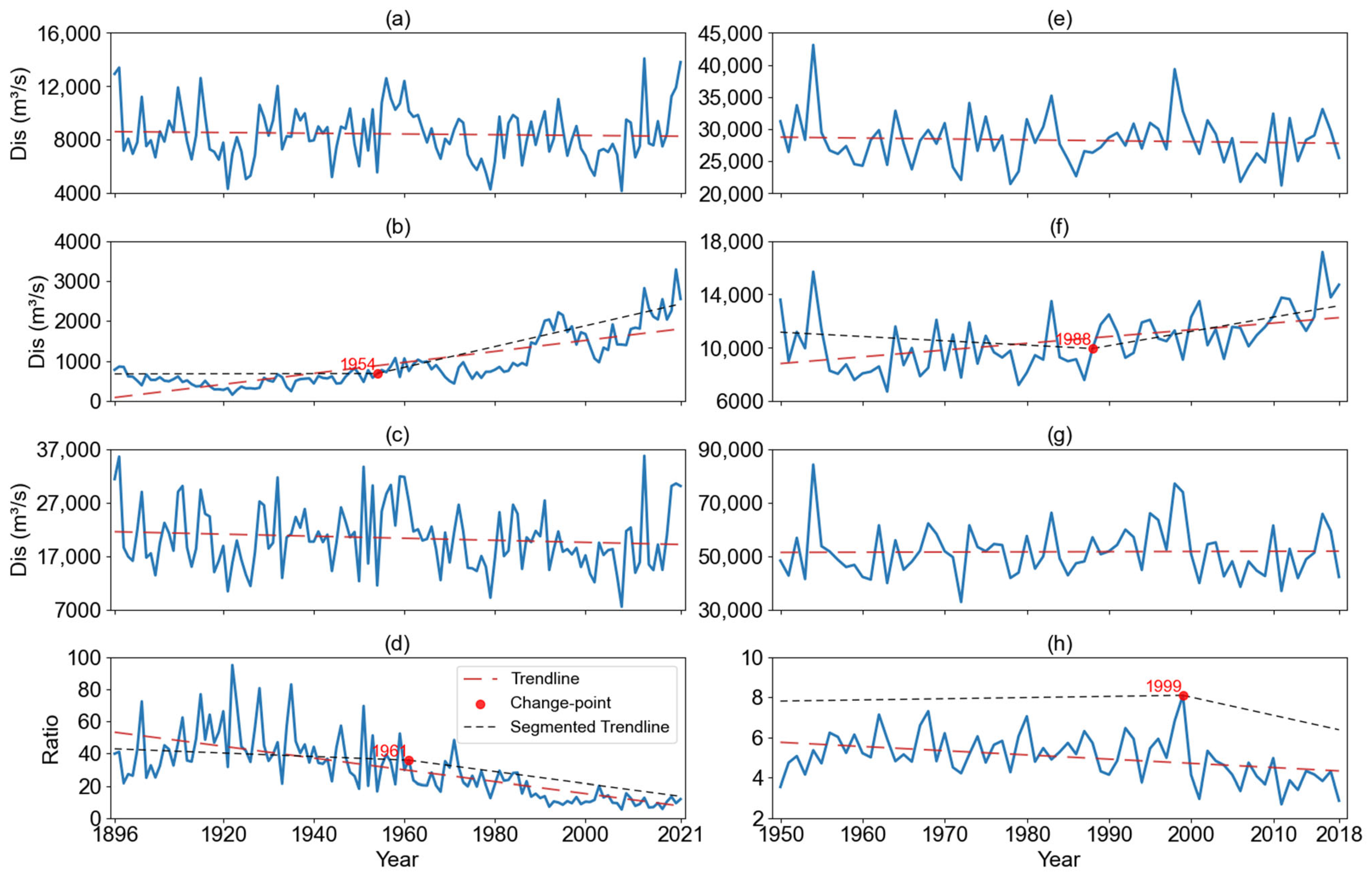
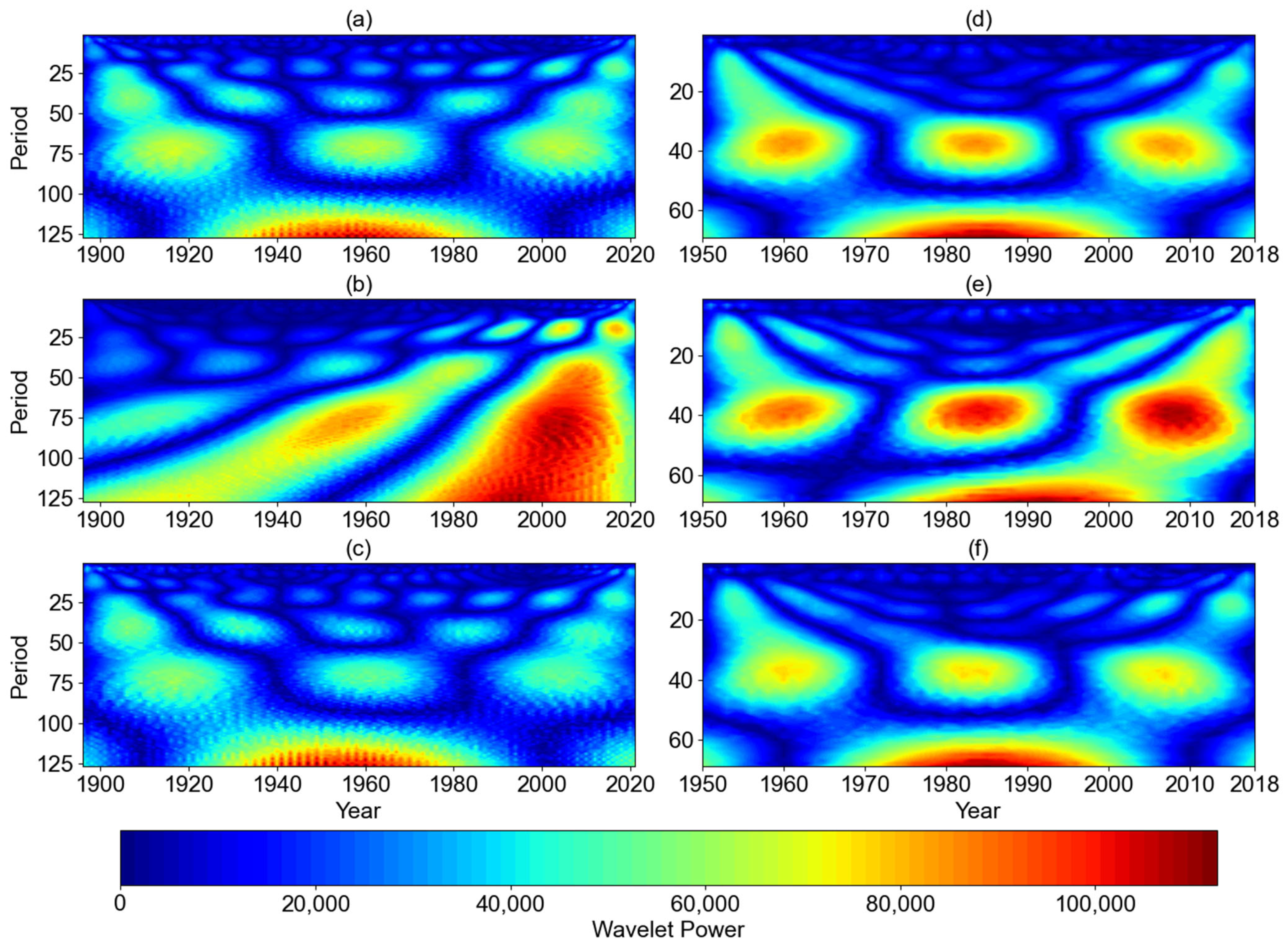
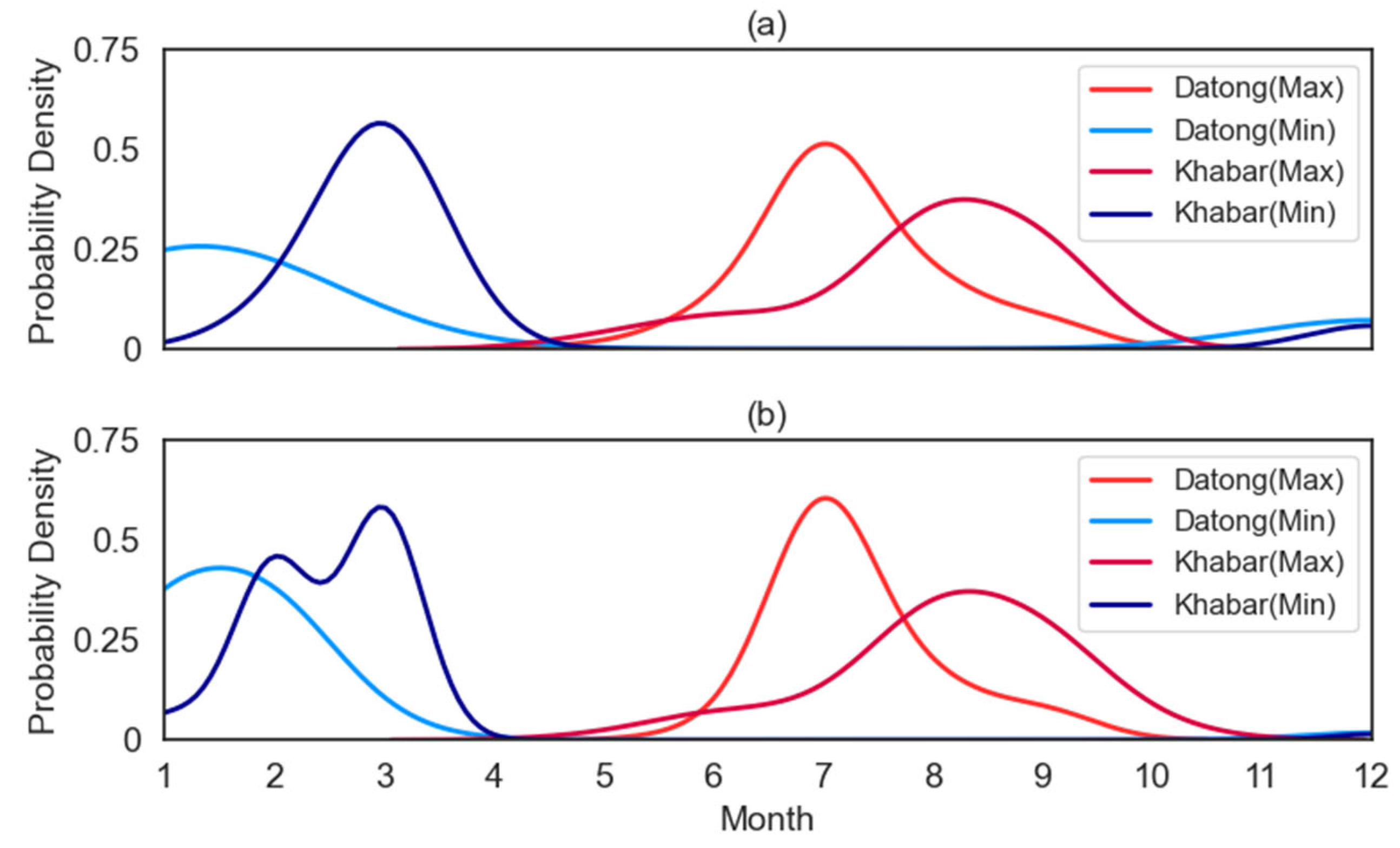
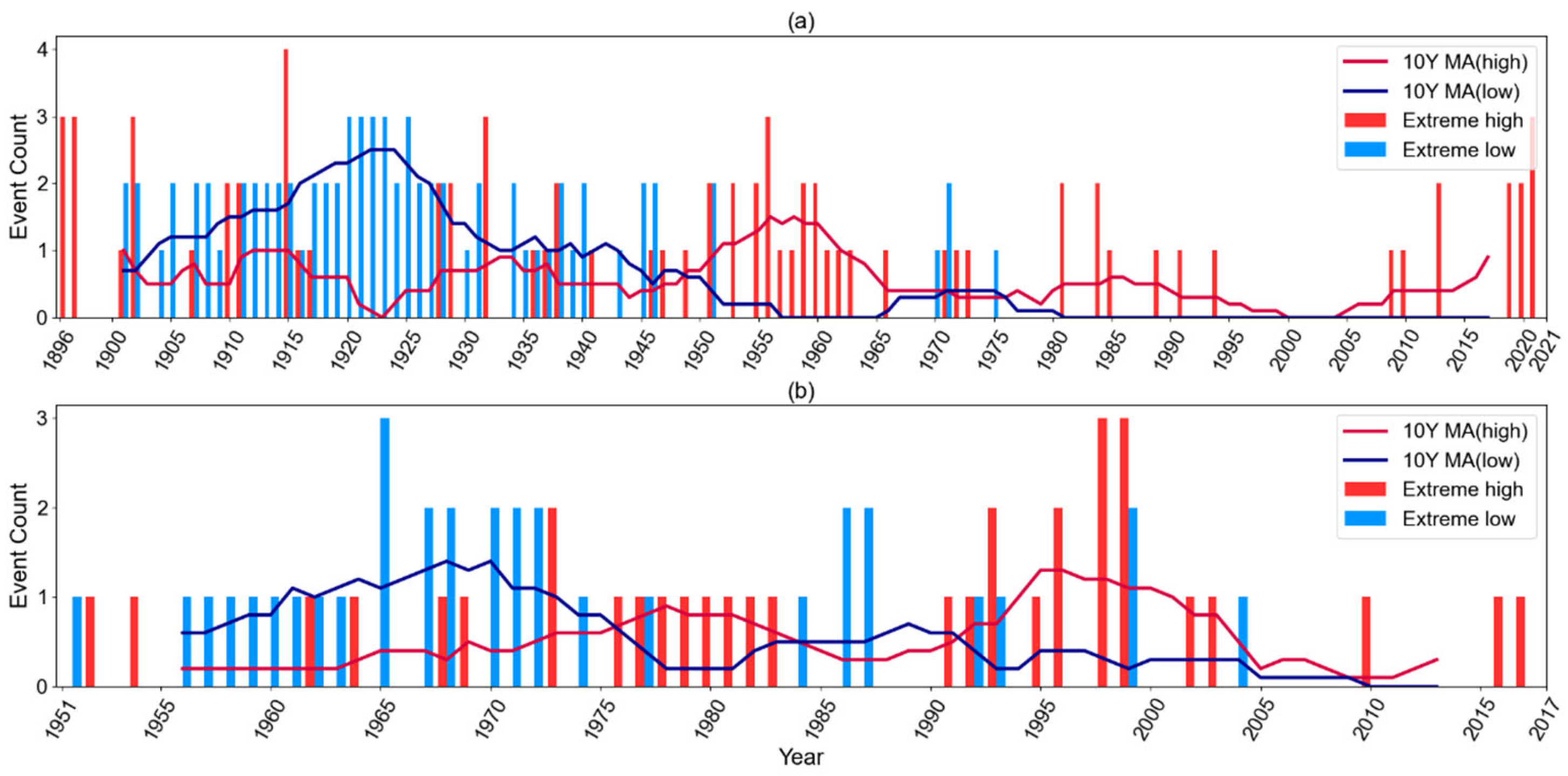
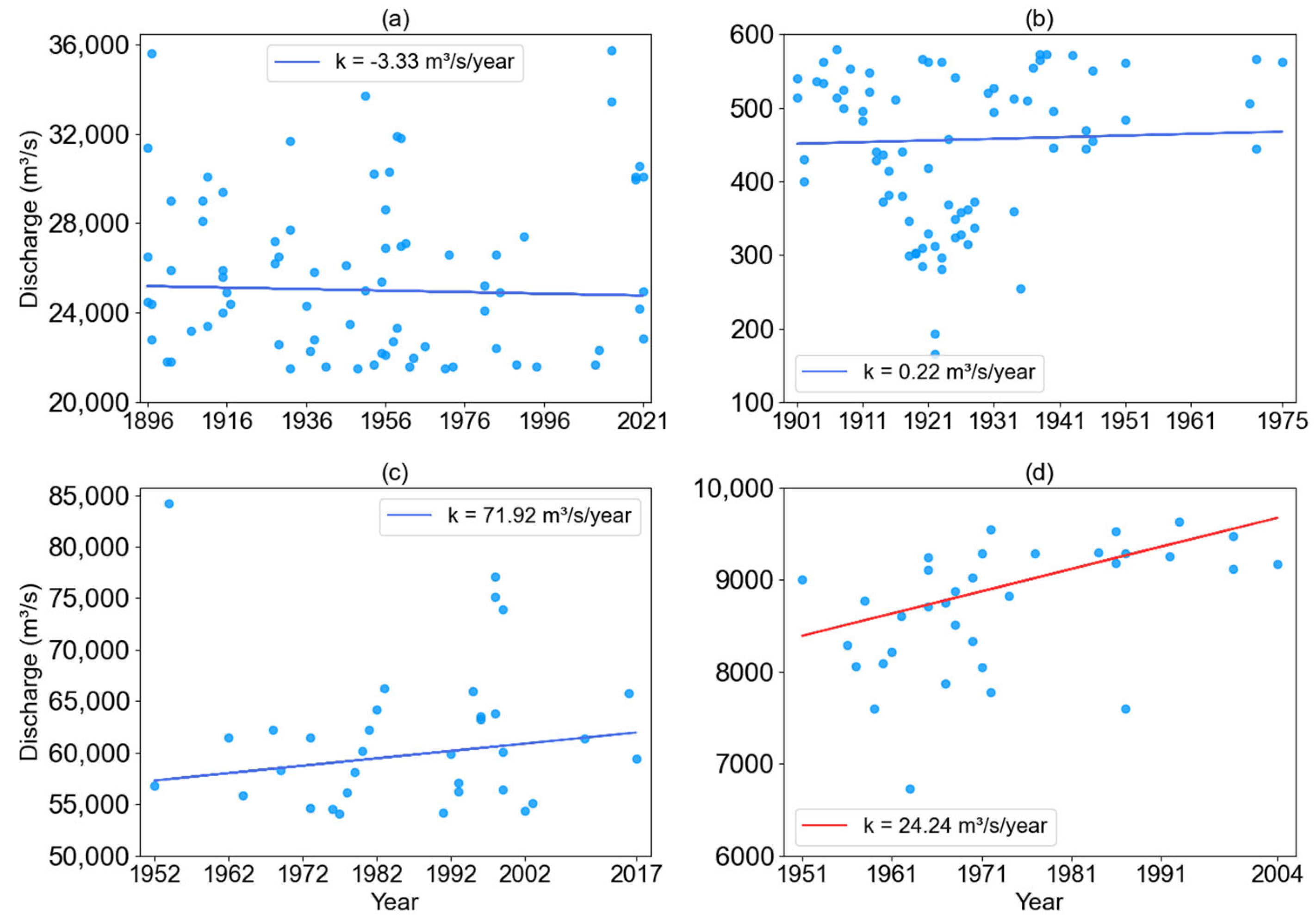
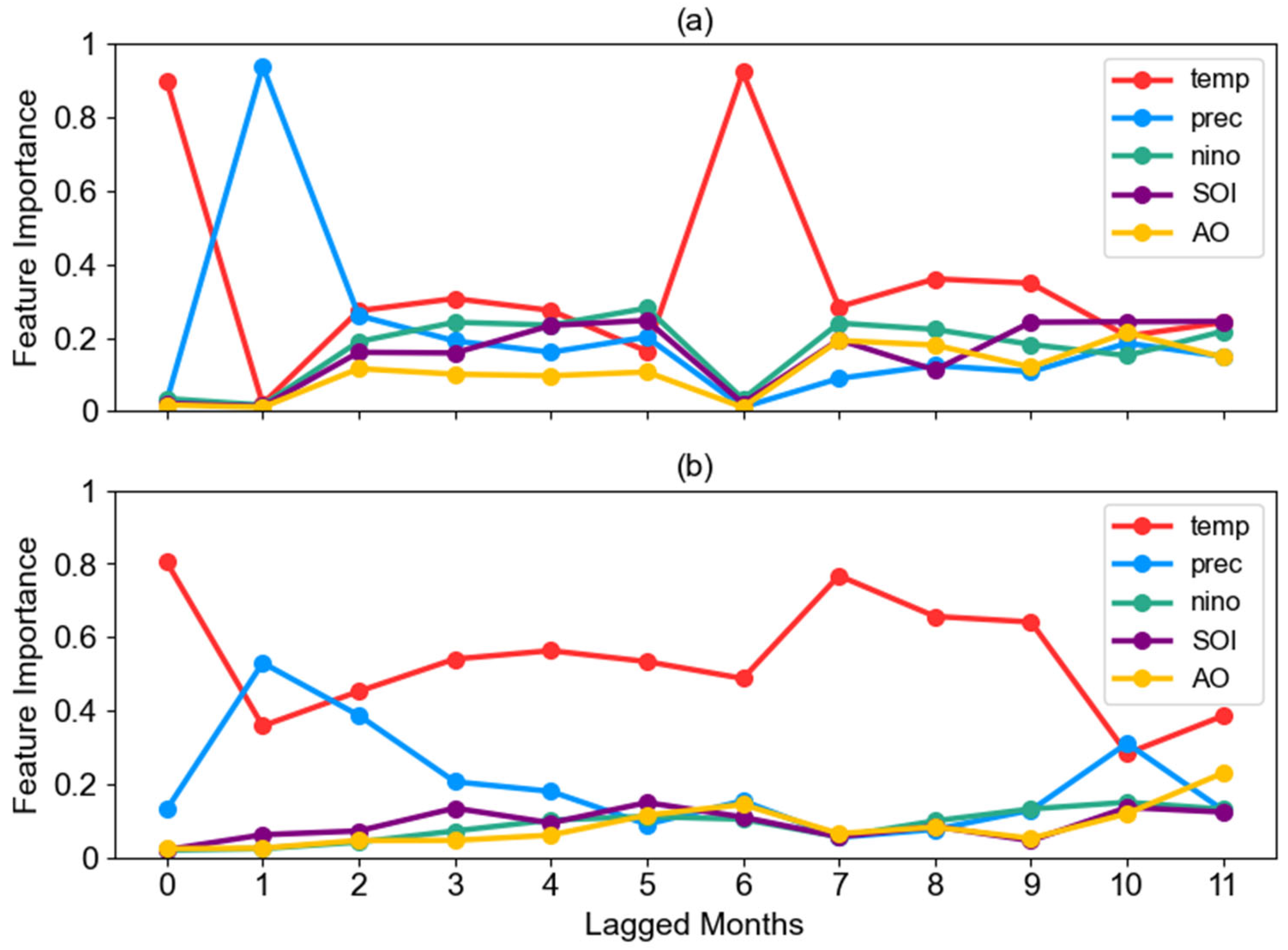
| Station | Drainage Area/km2 | Location | Period | Temporal Resolution |
|---|---|---|---|---|
| Khabarovsk | 1,630,000 | 48.43° N, 135.05° E | 1896–2021 | Monthly |
| Datong | 1,705,383 | 30.77° N, 117.62° E | 1950–2018 | Monthly |
| Reservoirs | Basin | Start Year | Oper. Year | Total Cap. (108 m3) | Active Cap. (108 m3) |
|---|---|---|---|---|---|
| Zeya | Amur | 1964 | 1975 | 684 | 383 |
| Bureya | Amur | 1985 | 2009 | 209.4 | 115 |
| Three Gorges | Yangtze | 1994 | 2009 | 393 | 221.5 |
| Gezhouba | Yangtze | 1970 | 1988 | 15.8 | - |
| Station | Mean Discharge | Flood Threshold | Mean Flood Discharge | Drought Threshold | Mean Drought Discharge | No. of Events |
|---|---|---|---|---|---|---|
| Khabarovsk | 8431.5 | 21,500.0 | 25,824.9 | 581.2 | 624.0 | 76 (each type) |
| Datong | 28,422 | 53,846.5 | 61,573.6 | 9638.2 | 8710.5 | 34 (each type) |
| Khabarovsk | Datong | |||||||
|---|---|---|---|---|---|---|---|---|
| Month | Avg Dis | CV | CP | Trend | Avg Dis | CV | CP | Trend |
| 1 | 1512 | 50.88 | 1987 | ↑ | 12,060 | 26.71 | 1988 | ↑ |
| 2 | 1099 | 66.42 | 1954 | ↑ | 12,717 | 25.4 | 1987 | ↑ |
| 3 | 997 | 70.52 | 1954 | ↑ | 17,051 | 28.5 | 1987 | ↑ |
| 4 | 3764 | 40.18 | 1960 | ↑ | 24,620 | 19.33 | — | — |
| 5 | 12,274 | 28.6 | — | — | 33,642 | 22.7 | 1983 | — |
| 6 | 13,964 | 32.6 | 1973 | ↓ | 40,471 | 18.22 | — | — |
| 7 | 13,909 | 32.71 | — | — | 51,921 | 18.59 | — | — |
| 8 | 17,877 | 32.26 | — | — | 43,331 | 21.57 | — | — |
| 9 | 17,610 | 36.21 | — | — | 36,765 | 23.48 | — | — |
| 10 | 11,859 | 35.92 | — | — | 30,698 | 21.64 | 1985 | ↓ |
| 11 | 4300 | 41.71 | — | — | 22,489 | 21.62 | 1983 | ↓ |
| 12 | 1951 | 36.4 | 1990 | — | 14,549 | 21.48 | — | ↑ |
Disclaimer/Publisher’s Note: The statements, opinions and data contained in all publications are solely those of the individual author(s) and contributor(s) and not of MDPI and/or the editor(s). MDPI and/or the editor(s) disclaim responsibility for any injury to people or property resulting from any ideas, methods, instructions or products referred to in the content. |
© 2025 by the authors. Licensee MDPI, Basel, Switzerland. This article is an open access article distributed under the terms and conditions of the Creative Commons Attribution (CC BY) license (https://creativecommons.org/licenses/by/4.0/).
Share and Cite
Ma, Q.; Wang, J.; Lei, N.; Zhou, Z.; Liu, S.; Makhinov, A.N.; Makhinova, A.F. Nonstationary Streamflow Variability and Climate Drivers in the Amur and Yangtze River Basins: A Comparative Perspective Under Climate Change. Water 2025, 17, 2339. https://doi.org/10.3390/w17152339
Ma Q, Wang J, Lei N, Zhou Z, Liu S, Makhinov AN, Makhinova AF. Nonstationary Streamflow Variability and Climate Drivers in the Amur and Yangtze River Basins: A Comparative Perspective Under Climate Change. Water. 2025; 17(15):2339. https://doi.org/10.3390/w17152339
Chicago/Turabian StyleMa, Qinye, Jue Wang, Nuo Lei, Zhengzheng Zhou, Shuguang Liu, Aleksei N. Makhinov, and Aleksandra F. Makhinova. 2025. "Nonstationary Streamflow Variability and Climate Drivers in the Amur and Yangtze River Basins: A Comparative Perspective Under Climate Change" Water 17, no. 15: 2339. https://doi.org/10.3390/w17152339
APA StyleMa, Q., Wang, J., Lei, N., Zhou, Z., Liu, S., Makhinov, A. N., & Makhinova, A. F. (2025). Nonstationary Streamflow Variability and Climate Drivers in the Amur and Yangtze River Basins: A Comparative Perspective Under Climate Change. Water, 17(15), 2339. https://doi.org/10.3390/w17152339







